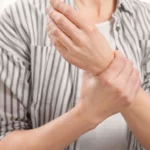Rheumatoid Arthritis Pain Relief Without Medication – A Practical Guide
Looking for ways to ease rheumatoid arthritis pain without relying on medication? You’re not alone! In this article, we’ll explore natural methods to help manage your symptoms and improve your quality of life.
Rheumatoid arthritis (RA) is a chronic inflammatory disease that affects the joints, causing pain, stiffness, and swelling. While medication plays a significant role in managing RA, many people are looking for ways to relieve the pain without relying on drugs. Whether you’re dealing with side effects or prefer to avoid medication altogether, there are several effective non-medication strategies that can help.
In this guide, we’ll explore practical approaches to managing RA pain, focusing on natural remedies, lifestyle changes, and simple exercises. Let’s dive in!
Understanding Rheumatoid Arthritis Pain
Before jumping into ways to relieve the pain, it’s important to understand why RA causes discomfort. The pain is typically due to inflammation in the joints, especially in areas like the hands, knees, and wrists. When the immune system attacks healthy tissue, it causes the joints to become swollen, which results in pain and stiffness.
RA pain can vary from mild to severe, and flare-ups can occur unexpectedly. The good news? There are natural ways to manage this pain and even reduce the frequency of flare-ups. Let’s take a look at how.

Natural Ways to Relieve Rheumatoid Arthritis Pain
1. Regular Exercise and Stretching
Exercise is one of the most effective ways to manage RA pain without medication. It might sound counterintuitive, especially when your joints are hurting, but staying active can actually reduce pain and improve mobility.
Low-impact exercises such as walking, swimming, and cycling are great options for people with RA. These activities help maintain joint flexibility, strengthen muscles around the joints, and reduce inflammation. Plus, regular movement can release endorphins, your body’s natural painkillers, which help improve your mood and reduce the perception of pain.

2. Heat and Cold Therapy
Applying heat or cold to affected joints is another simple but powerful way to ease pain. Heat can help relax and soothe tense muscles and joints, while cold therapy can numb the area and reduce inflammation.
Use a warm compress, heating pad, or take a warm bath to ease stiffness. For cold therapy, try ice packs wrapped in a cloth or a bag of frozen peas. Just be sure not to apply cold or heat directly to the skin—always use a barrier to avoid burns or frostbite.
3. Anti-Inflammatory Diet
Certain foods can help reduce inflammation and ease RA pain. An anti-inflammatory diet rich in fruits, vegetables, whole grains, and omega-3 fatty acids is beneficial. Foods like salmon, walnuts, and flaxseeds are great sources of omega-3s, which have been shown to reduce inflammation in the body.
Avoid processed foods, refined sugars, and trans fats, as they can trigger inflammation. A well-balanced diet can also help manage weight, taking the pressure off your joints, which may further reduce pain.

4. Acupuncture
Acupuncture has been practiced for centuries as a way to relieve pain and promote healing. This ancient technique involves inserting thin needles into specific points on the body to stimulate energy flow. Many people with RA report experiencing pain relief after acupuncture treatments, possibly due to its ability to trigger the release of endorphins and other chemicals that reduce inflammation.
While the research on acupuncture for RA is still ongoing, numerous studies suggest it can be effective in reducing joint pain and improving function in those with RA.
5. Mind-Body Techniques
Living with chronic pain can be mentally exhausting, which is why managing the psychological aspects of RA is just as important as dealing with the physical symptoms. Practices like meditation, deep breathing exercises, and yoga can help reduce stress and improve pain management.
Mindfulness meditation, in particular, has been shown to help people cope with chronic pain by changing the way the brain processes pain signals. Taking a few minutes each day to relax, breathe deeply, and clear your mind can make a big difference in how you experience RA pain.
6. Herbal Supplements
Certain herbs and supplements may offer pain relief for people with RA. Turmeric, for example, contains curcumin, a compound that has powerful anti-inflammatory properties. Some studies suggest that curcumin can help reduce joint pain and stiffness in people with RA.
Ginger is another herb with anti-inflammatory effects that may help reduce pain. Fish oil supplements, rich in omega-3 fatty acids, can also help lower inflammation in the body.
Always check with your healthcare provider before starting any herbal supplements, especially if you’re taking other medications.
Daily Lifestyle Changes for Managing RA Pain
1. Maintain a Healthy Weight
Carrying extra weight puts additional stress on your joints, especially the knees, hips, and spine. If you’re overweight, losing even a small amount of weight can significantly reduce joint pain and improve mobility.
A combination of healthy eating and regular exercise can help you achieve and maintain a healthy weight.
2. Rest and Sleep
While staying active is crucial, so is resting. Your body needs time to recover from physical activity, and getting enough sleep is essential for healing and reducing inflammation.
Try to aim for 7-9 hours of quality sleep each night. Establish a relaxing bedtime routine and create a comfortable sleep environment to promote restorative sleep.
Conclusion
Living with rheumatoid arthritis can be challenging, but with the right strategies, you can manage your pain and improve your quality of life without relying on medication. From regular exercise to heat therapy and diet changes, there are plenty of natural ways to relieve RA pain. It’s all about finding what works best for you and sticking with it.
Remember, always consult with your healthcare provider before making any significant changes to your treatment plan, especially if you’re combining natural remedies with medication.

Appendices
References
- National Institute of Arthritis and Musculoskeletal and Skin Diseases. (2024). Rheumatoid Arthritis. Read Article
- Smith, J., & Johnson, L. (2023). Natural Pain Relief for Arthritis. Journal of Rheumatology, 58(3), 450-456. Read Article
- American College of Rheumatology. (2024). Non-Medication Treatments for RA. Read Article
FAQs
- Can exercise really help reduce RA pain? Yes, low-impact exercises like swimming, walking, and cycling can help reduce pain by improving joint mobility and strength. They also reduce inflammation.
- Is turmeric effective for RA pain relief? Yes, turmeric contains curcumin, which has anti-inflammatory properties that can help alleviate joint pain associated with RA.
- How long should I rest after a flare-up? It’s important to listen to your body. Rest is crucial, but make sure to resume activity as soon as you feel able, to avoid stiffness and further pain.
- Can I use heat therapy for swollen joints? Heat therapy is more effective for easing muscle stiffness and pain, while cold therapy is better for reducing inflammation and swelling.
- Are herbal supplements safe to use with RA? Many herbal supplements, such as turmeric and ginger, can be beneficial, but you should consult with your healthcare provider before starting any new supplement.
Disclaimer: The information provided in this article is for educational purposes only and does not substitute for professional medical advice. Always consult with your healthcare provider before making any changes to your treatment or lifestyle.












